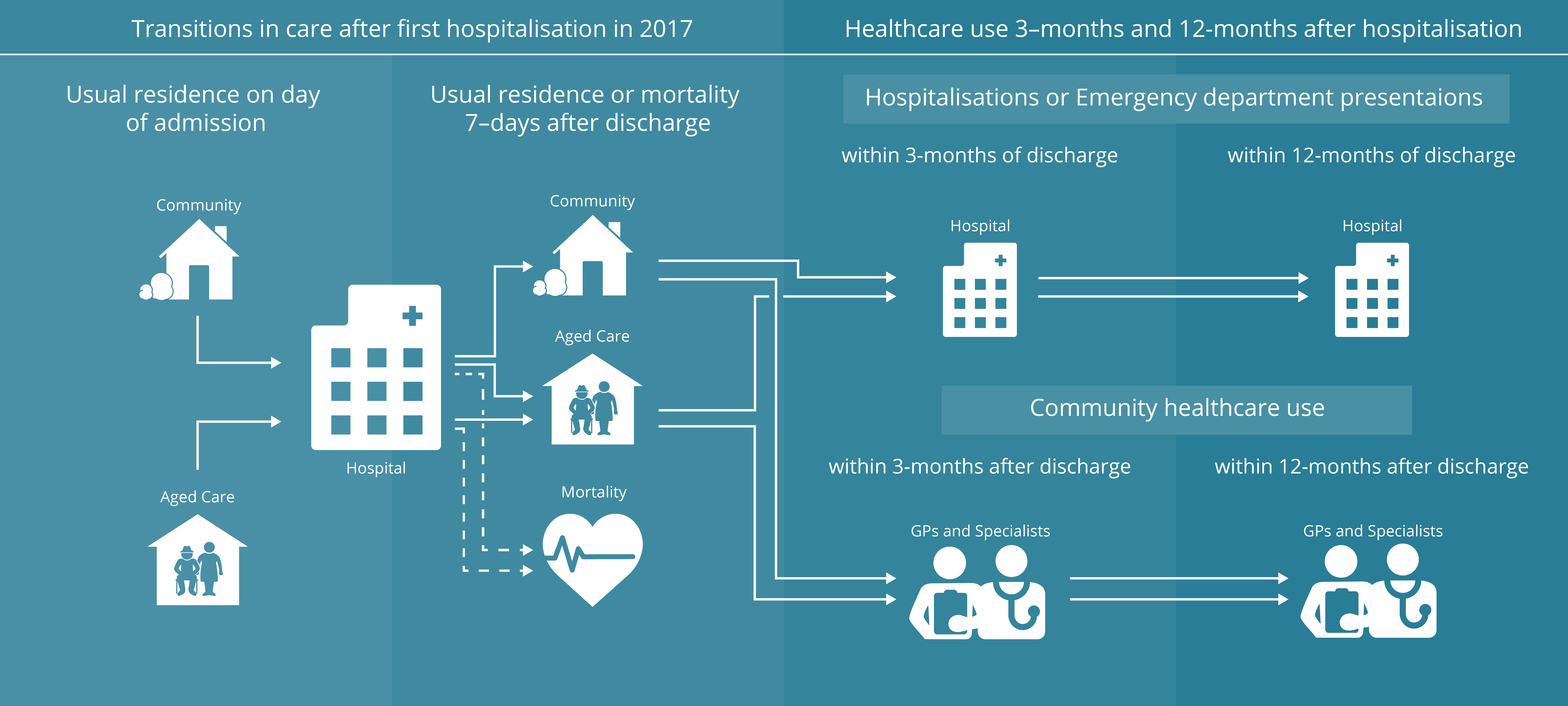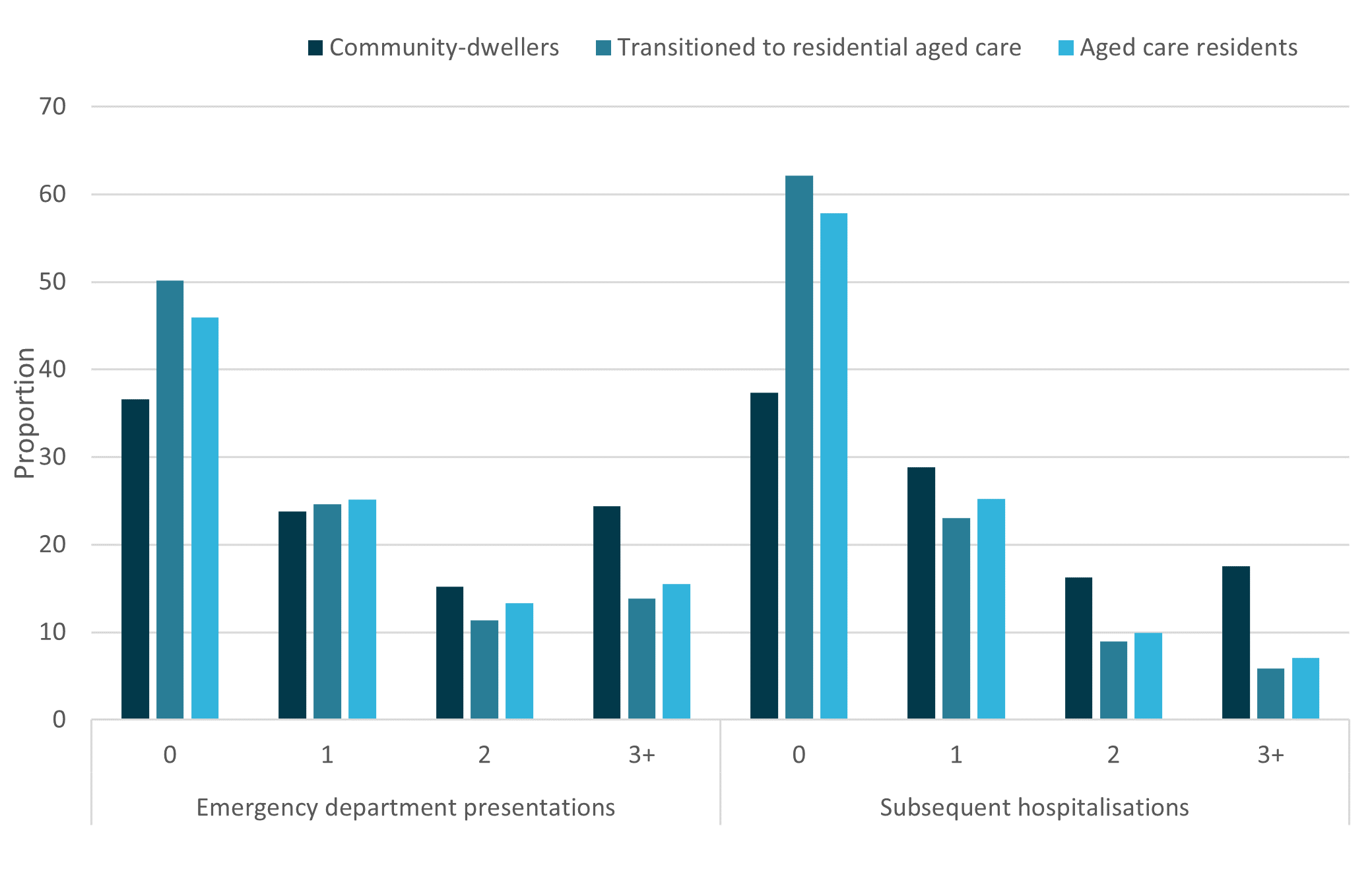Health services used in the year after first hospitalisation for people living with dementia
This page presents the use of key healthcare services by people living with dementia in the 12-months after discharge from their first hospitalisation in 2017. This includes hospital admissions, emergency department presentations and select Medicare-subsidised services.
These services are important in the treatment and management of dementia (and other co-morbidities) and are often recommended after a significant change in a person’s health status – as may occur after a hospitalisation. Understanding use of these health services in the year after first hospitalisation and how this differs by people’s usual residence can help to identify people who may be underserved.
Findings are presented by change in usual residence within 7-days of discharge from hospital, and therefore reflect where people were living after their first hospitalisation. To ensure a fair comparison between groups, results are limited to people who survived for at least 12-months after discharge from hospital: community-dwellers, people who transitioned into residential aged care and aged care users.

Hospitalisations and emergency department presentations
Community-dwellers were more likely to have an emergency department (ED) presentation (63%) or subsequent hospitalisation (62%) in the 12-months after discharge compared with people who were living in residential aged care (54% and 42%, respectively) and people who transitioned into residential aged care after their first hospitalisation (50% and 38%, respectively).
Community-dwellers were also more likely to have three or more ED presentations or subsequent hospitalisations compared with aged care users and people who transitioned to residential aged care after their first hospitalisation (Figure 16 and Tables S1.26 and S1.27).
Figure 16 Number of emergency department presentations and subsequent hospitalisations in the 12-months after discharge for people living with dementia, by change in usual residence in the 7-days after discharge

Note, this was limited to people living with dementia who survived for 12-months after discharge from their hospitalisation
Source: AIHW NIHSI 2018–19, analysis of NIHSI.
Community-based healthcare services
Figure 17 shows that in the 12-months after discharge from hospital:
- almost all people living with dementia had one or more GP consultations (94%)
- over half had a specialist consultation (56%) or received a chronic disease management service (57%)
- less than half had an allied health service (41%)
- less than 1 in 3 had a medication management review (27%)
- less than 1 in 7 people living with dementia received a geriatrician referred management plan (13%).
GP consultations
Of the 94% of people living with dementia who had one or more Medicare-subsidised GP consultations in the 12-months after discharge from their first hospitalisation, most people (96%) saw a GP in the 3-months after their first hospitalisation (Table S1.28).
The median number of GP consultations in the 12-months after discharge was:
- 17 for community-dwellers
- About 27 for aged care residents and people who transitioned to residential aged care after their first hospitalisation (Table S1.29).
Specialist consultations
Over half (56%) of people living with dementia had a Medicare-subsidised specialist consultation in the 12-months after discharge from hospital (Table S1.28).
The proportion of people who had one or more specialist consultations in the 12-months after discharge was:
- 66% for community-dwellers
- 46% for people who transitioned to live in residential aged care
- 42% for aged care residents
Among those who had one or more specialist consultations, about 60% had this consultation in the 3 to 12-months after discharge from their first hospitalisation.
Chronic disease management services
Over half (57%) of people living with dementia had a Medicare-subsidised chronic disease management service in the 12-months after discharge from hospital (Table S1.28). The proportion of people who had one or more chronic disease management services in the 12-months after discharge was:
- 58% for community-dwellers
- 58% for people who transitioned to live in residential aged care
- 53% for aged care residents
Among those who received a chronic disease management service, people who transitioned into residential aged care were more likely to receive a chronic disease management service in the 3-months after discharge from hospital (56%) than people who remained living in residential aged care (49%) or remained living in the community (45%).
Chronic disease management services include the preparation and review of GP management plans, team care arrangements and multidisciplinary care plans. People with chronic or terminal conditions can access chronic disease management services from their GP (sometimes in collaboration with other health or care professionals), to help ensure they receive structured and coordinated care that will help them to achieve their current health goals.
GP management plans with regular review are a recommended strategy to monitor the progress of each person living with dementia to ensure their goals are being met (Pond 2012). These plans should be regularly reviewed, either every six months, or as clinically necessary up to once every three months.
Geriatrician referred plans
Less than 1 in 7 people living with dementia (13%) had a Medicare-subsidised geriatrician referred plan in the 12-months after discharge from their first hospitalisation. By change in usual residence for people living with dementia, this was:
- 14% for community-dwellers
- 14% for people who transitioned into residential aged care
- 10% for aged care residents.
About 40% of people who had a geriatrician referred plan received this in the 3 to 12-months after discharge from their first hospitalisation (Table S1.28).
People aged 65 and over with complex health issues or who are at risk of poor health outcomes can be referred by their GP for a comprehensive assessment and management plan (geriatrician referred plan) by a consultant physician or specialist in geriatric medicine. The assessment includes a medication review, advance care planning and a review of the person’s physical, social, and emotional health.
Medication management reviews
Only 27% of people living with dementia had a Medicare-subsidised medication management review in the 12-months after discharge from their first hospitalisation. Among people who had a medication management review, the majority (76%) received this in the 3 to 12-months after discharge from their first hospitalisation (Table S1.28).
The proportion of people who had a medication management review varied by change in usual residence after discharge:
- 51% for people who transitioned into residential aged care
- 33% for aged care residents
- 16% for community-dwellers
People can access medication reviews once every 12-months, or after a significant change in the person’s condition or prescribed medications. As examining prescription medications was out of scope of the current report it is unclear what proportion of people living with dementia take medications and would require a medication management review.
Medication management reviews are conducted by GPs (in collaboration with community pharmacists or specialists) and involve reviewing the number and type of medicines that a person has been prescribed. This allows the risks and benefits of each medication, and potential interactions between medications, to be considered.
Allied health care services
Aged care residents were slightly more likely to have one or more Medicare-subsidised allied health care services in the 12-months after discharge from hospital (44%) compared with community-dwellers (40%) or people who transitioned into residential aged care after their first hospitalisation (38%).
Among people who received an allied health care service, aged care residents were also more likely to receive this service in the 3-months after discharge from hospital (65%) compared with people who remained living in the community (58%) or who transitioned into residential aged care after their first hospitalisation (42%)(Table S1.28).
Figure 17 Proportion of people living with dementia who accessed a Medicare-subsidised healthcare service in the 12-months after discharge
This figure is a bar chart and shows the proportion of people living with dementia who were aged care residents, community-dwellers or who transitioned to residential aged care in the 7-days after discharge from their first hospitalisation in 2017 and accessed Medicare-subsidised community-based healthcare services in the 12-months after discharge. Most people had one or more GP consultations (over 94%) and very few people had a geriatrician-referred management plan (less than 15%).

Note, this was limited to people living with dementia who survived for 12-months after discharge from their hospitalisation
Source: AIHW NIHSI 2018–19, analysis of NIHSI.
References
Pond D (2012). Dementia – an update on management. Australian Family Physician. Dec;41(12):936-9.


